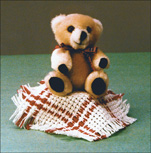|
English
instructions:
On each student's desk place one 4B pencil and one teddy positioned on checked
cloth as shown in the photo.
Note: Place the
model in the centre of the student's table, behind the drawing board. Note that
the teddy is to remain in its assigned position throughout the drawing activity.
This is important for scoring purposes.
In this
activity I want you to make a drawing of the teddy sitting on the checked cloth
just as you see it in front of you.
Before you start you might
like to have a closer look at the teddy. You can do that now.
Allow students to hold
and examine the model. Then ensure that the model is placed back in the correct
position.
It is important
that you don't touch the teddy or change its position while you are making your
drawing. Make sure it is in the same position all the time.
Try to make your drawing
of the teddy as real as possible. Just as you see it.
It's a good idea to start
with very light lines, then to make them clearer when you are satisfied with the
way you have drawn them.
You don't need to use a
rubber. Just change your lines if you need to.
You have 10 minutes to
make your drawing. I want you to spend all of that time on your drawing so that
it's as good as you can make it. Don't worry if you don't actually finish your
drawing in 10 minutes. Just do your very best work.
I will let you know when
you have 5 minutes left.
You can start your drawing
as soon as I have given you your paper.
Give each student their
paper and drawing board. When 5 minutes have elapsed:
You've had half the time
for making your drawing and you have 5 minutes left. Use all of the time so that
your drawing is as good as you can make it.
When time is up:
It's time
to finish now. I want you to stop work, put your things down, and look at your
paper.
|
Mäori
instructions:
Ki
runga i te tëpu o ia äkonga whakatäkotohia tëtahi pene räkau
4B me tëtahi teti kei te noho i runga i tëtahi papanga whai tapawhä,
përä i te whakaahua.
Tënä:
whakanohoa te tauira, i te pokapü [centre] o te tëpu a te äkonga
i muri i te papa tä. Tënä anö, ka noho te teti ki töna
ake nohanga i te wä o te mahi tä. He mea motuhake tënei mö
te tikanga o te whai tapeke [scoring].
Nä,
ko täu mahi, ko te tä i te teti e noho ana i runga i te papanga whai
tapawhä, kia rite tonu ki täu e kite ana, i mua tonu i a koe.
I mua i
tö tïmatanga, ki te pïrangi koe ki te äta titiro ki te teti,
me tirohia inäianei.
Tukuna
atu ngä äkonga ki te pupuri, ki te äta titiro hoki ki te tauira.
Kätahi te kaiako ka äta whakanoho anö te teti, ki töna ake
nohanga tika.
I a koe
e tä ana i tö whakaahua, kaua e pä atu, e neke ränei i te
nohanga o te teti, he mea tino motuhake tënei. Kia mau tonu ki töna
nohanga tika, i te wä katoa. Me whai kaha koe, kia tüturu rite tö
whakaahua ki te tauira. Me hängai tika ki täu e kite ana. He whakaaro
pai ki te timata i ngä rärangi mämä i te tuatahi, kätahi
ka äta tä i te wä kua tau tö hiahia.
Hei aha
kë te rapa. Ki te hiahia koe, me whakarerekë noa ngä rärangi.
Tekau meneti
aü ki te täi tö whakaahua. Me whakapau pai koe i te wä, kia
puta ai tö whakaahua tino papai. Kaua e äwangawanga, mena käore
e oti i a koe i te tekau meneti. Ko te mea nui, ko te whakapau kaha, kia puta
ngä painga e oti ai i a koe.
Ka whakamöhio
atu ahau, ina, e 5 meneti kei te toe.
Me timata
koe ina ka hoatu ahau i tö pepa.
Hoatu
he pepa me te papa tä ki ia äkonga.
Kia
pau ngä meneti e 5.
Kua pau
te hauruatanga o te wä, ana, e 5 meneti kei te toe. Whakapaua tënei
wä kia tino ätaahua rawa tö whakaahua.
Kia
pau te wä:
Käti,
me mutu tö mahi inäianei.
Waihotia o taputapu, ana, me titiro koe ki tö pepa.
|
